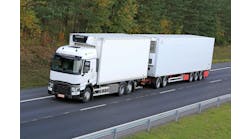| ||
| A new set of requirements for handling domestic and international air cargo is in the works which, its adherents say, will ensure safe and secure borders without impeding commerce. When the Transport Security Administration (TSA) (www.tsa.gov) first announced its Air Cargo Strategic Plan last November, it was to serve as an interim step until a full set of requirements were developed to present “a comprehensive approach that will significantly enhance air cargo security,” says Tom Ridge, secretary for the U.S. Department of Homeland Security (DHS) (www.dhs.gov). The Plan — developed with input from the DHS, the U.S. Bureau of Customs and Border Protection and a number of commercial suppliers — follows the model established in maritime cargo. First real steps have been to randomly inspect all air cargo and to require international all-freight air cargo carriers to follow the same rules and regulations as domestic carriers. One key component of the TSA approach will be close inspection of cargo being offered by unknown shippers. This is a cornerstone of many DHS efforts. At a minimum, shippers should continue to join C-TPAT (Customs-Trade Partnership Against Terrorism) to become known to the governmental agencies dealing with cross-border trade issues. Recognizable air carriers have been part of TSA operations, and while none of them will discuss internal and cooperative security measures already underway, they all have extended assistance to the shipping community in anticipation of any final regulations. “We are C-TPAT registered,” notes Kristin Krause, a spokesperson for FedEx Freight (www.fedex.com). “We have a consulting practice in our FedEx Trade Networks that helps customers become C-TPAT compliant. It is a complex process, so we know all of the paperwork that has to be filed and the things you have to do to receive C-TPAT recognition.” Since its inception, TSA has been working very closely with UPS (www.ups.com), notes UPS’ manager of public affairs, Dave Bolger. “TSA has been to our Worldport facility in Louisville, our facility in Chicago — which is our biggest sorting hub — and to Ontario, Calif., which is a major international gateway,” he notes. “They have been throughout our system, as they have with other carriers.” UPS focuses on communications with its shipping community and keeping current with security regulations. “In many cases, shippers are so focused on getting the product to market that they are not as aware of security needs,” Bolger observes. “We are in a unique environment and everyone has a role to play when transporting packages from one point to another, including the shipper.” From a security point of view, Bolger suggests shippers ask themselves these questions:
Bolger expects that by the second quarter of this year, TSA will issue proposed rules. In its initial Plan, TSA set forth four strategic objectives. Logistics Today followed up with the agency for a status report on those objectives. A TSA spokesperson indicates the DHS has improved some aspects of the Plan, and TSA has begun to implement various aspects of it: Enhance shipper and supply chain security. TSA has begun demanding screening of freight shipments by all-cargo carriers, whether domestic or international. TSA has indicated it will beef up “shipper and supply chain security through a more thorough vetting of shippers and indirect air carriers (IACs) applying for the Known Shipper program and validation.” The TSA spokesperson indicates that it has begun to build up the Known Shipper database and is working hand-in-hand with agencies like Customs and DHS, among others, Identify elevated risk cargo through prescreening. TSA has been using its Computer Assisted Passenger Prescreening System to identify travelers needing further screening. Similarly, working with carriers for a number of years, Customs has been using a data-based program to identify imported high-risk cargo. TSA will extend this practice to domestic cargo and is reaching out to Customs and the air cargo shipping community in order to develop a Cargo Prescreening System. Among other items of information to be incorporated in this system will be TSA Known Shipper and IAC databases. Identify technology for performing targeted air cargo inspections. The spokesperson indicates a strong commitment to putting existing and new technologies to work to improve the inspection of air cargo. In fact, TSA has issued a request for proposals (RFP) for technologies to be used in screening break bulk air cargo. Secure all-cargo aircraft through appropriate facility security measures. As the spokesperson explains, TSA is already moving to update security regulations for aircraft operators in regard to air cargo operating areas. It is presently working with all-cargo carriers to reach understanding on how best to strengthen security in these parts of their business. Carriers are not waiting for new TSA air cargo security regulations. For example, as FedEx’s Krause notes, “We’ve recently installed radiation detection equipment in our overseas locations. Our entire network is run on technology. Every package is tracked at least 12 or 15 times, so we know who the customer is, where the package is going, where it’s been, who dropped it off and so forth.” “Since September 11, we’ve rededicated ourselves to enhancing our security and our flow of commerce,” UPS’ Bolger notes. “We are looking at issues through those two lenses. We focus on improving and educating staff and shippers about security elements needed when cargo moves. We’re not waiting for TSA with a proposed or final rule, because we try to anticipate the next step and move to fill the requirement even before a rule is implemented.” LT | ||
Latest from Transportation & Distribution


